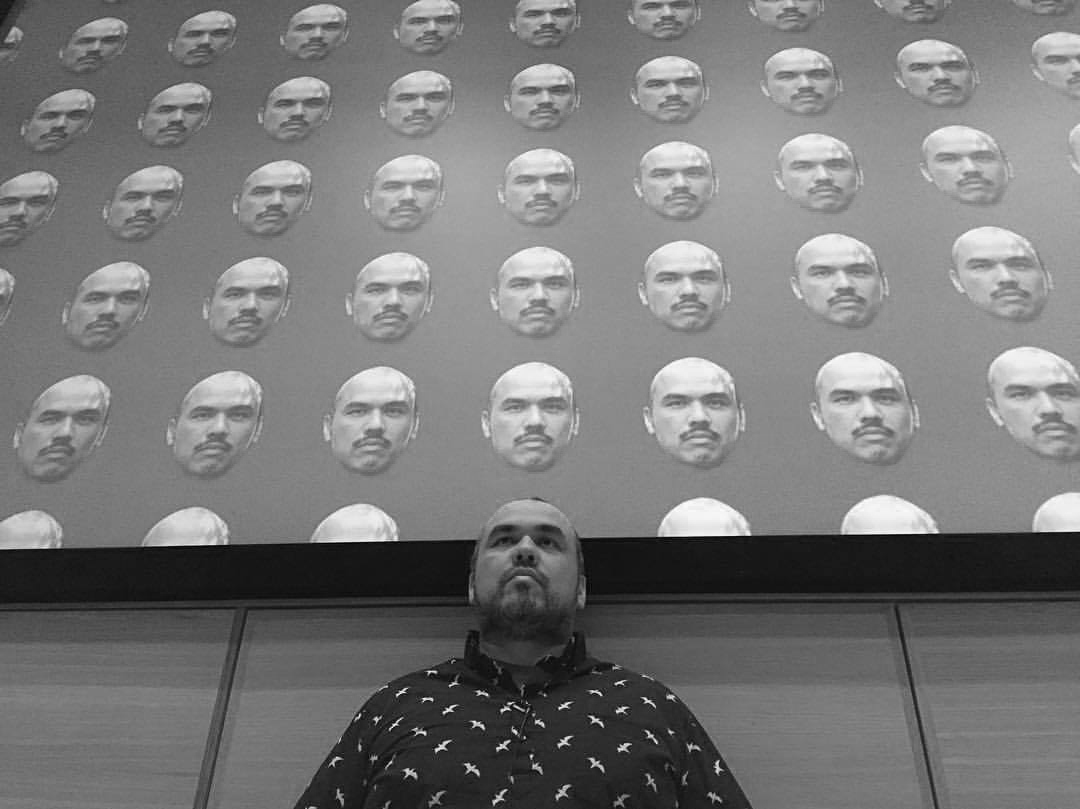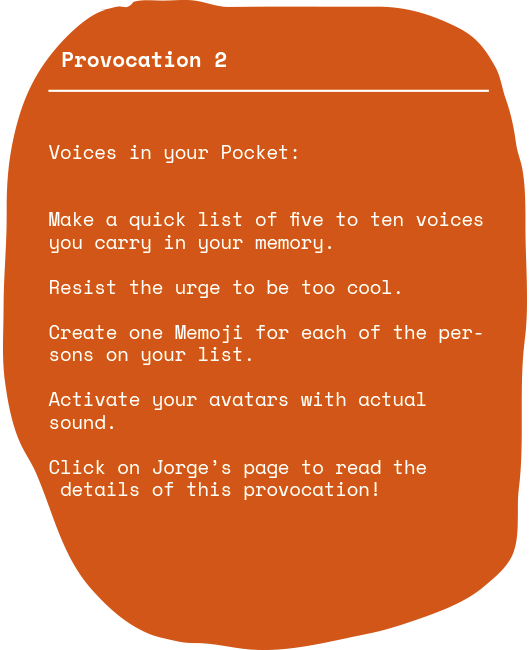Provocation 2:
Jorge Lucero
Jorge Lucero
︎Visit Jorge’s website


Provocation 2: Voices in your Pocket
The voices of others live in us. Interchangeably with touch, the spoken and sung words of others are primary pedagogy (a first means by which we learn about our worlds). We carry those voices—sometimes through recordings, but mostly through memory—into many of the things we do and become. Voices in Your Pocket is a portable monument that you build yourself and archive in your iPhone. The most exciting thing is that unlike other monuments this artwork can be continuously reworked and even shared with others via text messages.
1. To begin, own an iPhone with the capabilities to create personalized Memojis. (Please note: all the Memoji’s on this page should work. Click on them to play them as audio/visual files).
2. Make a quick list of five to ten voices you carry in your memory. These could be people in your intimate sphere of contacts or people you have never met before, but whose words you carry with you. Be careful not to overthink your list. Remember, you can always go back and swap out the “voices”.
3. Things to resist during the process of selection. Resist the urge to be too cool. Resist the urge/need to control the optics/narrative of your list (by going “diverse”, witty, or by trying to avoid controversy). Don’t immediately judge your choices too much. Try to be sincere even if your list is disproportionately one kind of person (e.g. men, relatives, authors, dead people, etc.). Remember that Voices in Your Pocket is a modifiable monument; so, if your list is “too much” of anything, you can always alter it later.
4. When you have your list, create one Memoji for each of the persons on your list. My initial group of voices includes Morrissey, JD Salinger, George Lucas, John Cage, Jesus, Yoko Ono, the Edge and Bono, Matthew Goulish, my father and my mother. If needed, use a photograph of the person in order to capture the person’s likeness as close as possible. You may, as I did with a black and white photograph of JD Salinger, chose a photograph from the time of that persons’ life that you prefer.


My Memoji of JD Salinger listening to the first page of The Catcher in the Rye,
5. Once you have created all of your Memoji’s, use the face recognition function on your phone to activate your avatars with actual sound. This sound can be your voice saying or singing the words from that person that you carry with you (see my mom and dad below), or you can find a an audio clip of your chosen person and then just mouth the words so that you’re controlling the Memoji like a puppet.
6. Once you have created all your Memojis and infused them with the “voice” from your memory, email only your Memojis with a list of their names to “Designing the Pluriversity”.
Here are my examples: Morrissey, George Lucas, John Cage, Jesus, Yoko Ono, the Edge, Bono, my mom, my dad, and JD Salinger.
BIO:
Jorge Lucero is an artist born, raised and educated in Chicago. He currently serves as Chair and Associate Professor of Art Education at the University of Illinois, Urbana-Champaign. Lucero's books include Mere and Easy: Collage as a Critical Practice in Pedagogy, Teacher as Artist-in-Residence: The Most Radical Form of Expression to Ever Exist, and the forthcoming What Happens at the Intersection of Conceptual Art and Teaching?. He is the author of numerous peer-reviewed articles and chapters in books. Lucero has exhibited, performed, and taught all over the U.S. and abroad. He received his degrees from the School of the Art Institute of Chicago and Penn State University. He is co-editor of the international journal Visual Arts Research and sits on the editorial boards for the Journal of Social Theory and Art Education, the Journal of Cultural Research in Art Education, and the Journal of Curriculum and Pedagogy.
Responses:
Gabriela M. G. M.
Sadie Garcia-Blanks
Nikolas M.
Noah T.
Gillian F.
Chloe Roman
Morgann Hopson
Anonymous
Anonymous
Maurice T.
Jorge Lucero is an artist born, raised and educated in Chicago. He currently serves as Chair and Associate Professor of Art Education at the University of Illinois, Urbana-Champaign. Lucero's books include Mere and Easy: Collage as a Critical Practice in Pedagogy, Teacher as Artist-in-Residence: The Most Radical Form of Expression to Ever Exist, and the forthcoming What Happens at the Intersection of Conceptual Art and Teaching?. He is the author of numerous peer-reviewed articles and chapters in books. Lucero has exhibited, performed, and taught all over the U.S. and abroad. He received his degrees from the School of the Art Institute of Chicago and Penn State University. He is co-editor of the international journal Visual Arts Research and sits on the editorial boards for the Journal of Social Theory and Art Education, the Journal of Cultural Research in Art Education, and the Journal of Curriculum and Pedagogy.
Responses:
Gabriela M. G. M.
Sadie Garcia-Blanks
Nikolas M.
Noah T.
Gillian F.
Chloe Roman
Morgann Hopson
Anonymous
Anonymous
Maurice T.
Devon M.
Tamara S.
Menna A.
Aaron B.